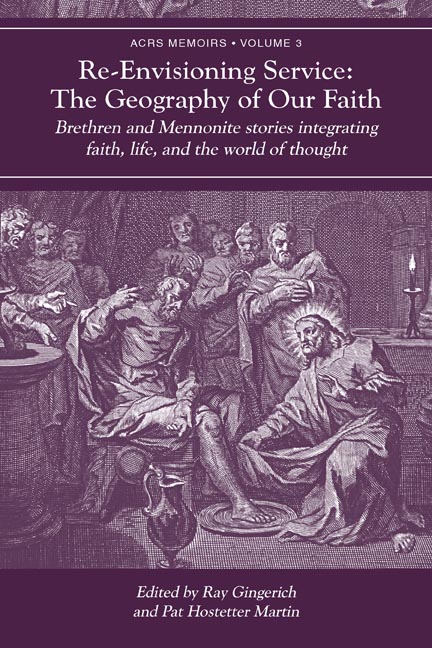|
|
Cover
RE-ENVISIONING
SERVICE
The Geography of
Our Faith
Edited by Ray Gingerich and Pat Hostetter Martin
|
This t hird
volume of essays
from the “Monday Morning Breakfast” series of the Anabaptist Center for
Religion and Society (ACRS) distinguishes itself from the previous two
volumes in several ways: First, rather than being focused on Eastern
Mennonite University faculty who are no longer actively engaged in the
classroom, the essays in volume three are organized around the
leitmotiv of service. In some of the essays this theme is much more in
evidence than in others. It should be noted that “service” is quite
broadly defined. For some of the authors it is quite literally a
rendering of their life’s work. hird
volume of essays
from the “Monday Morning Breakfast” series of the Anabaptist Center for
Religion and Society (ACRS) distinguishes itself from the previous two
volumes in several ways: First, rather than being focused on Eastern
Mennonite University faculty who are no longer actively engaged in the
classroom, the essays in volume three are organized around the
leitmotiv of service. In some of the essays this theme is much more in
evidence than in others. It should be noted that “service” is quite
broadly defined. For some of the authors it is quite literally a
rendering of their life’s work.
Most are quite aware that
theirs was an “alternative service,” alternative to “military
service”—alternative in method, with alternative support agencies. For
others “service” is more outward-looking, giving us an account of how
in the thought and in the institutional engagement that intertwined
them, life served as a catalyst in a larger movement of the
church—namely, the evolution of theology and practice within our
religious denominations. Specifically, the changing strategies of being
peacebuilders and of being a people of hope in a land that is not ours
are most clearly enunciated in the final segment (Part V) of the essays
of this collection.
Second, the first two volumes of The Geography of Our Faith,
particularly the earlier essays of volume one (Making Sense of the Journey: The
Geography of Our Faith—Mennonite Stories Integrating Faith and Life and
the World of Thought
(ACRS 2007, Cascadia edition 2009), constituted a series of
intellectual memoirs belonging to the genre of “how my mind has
changed.” The current collection of essays is more vocationally focused
and might reasonably be read from the perspective of “how my life’s
work has transformed me” into the person I now discover myself to be.
That is, service is seen less from the perspective of what it has done
for others and more with an eye on how those engaged in service have
themselves been served—i.e., been transformed. Each of these shifts in focus
deserves elaboration well beyond what is possible to provide here.
Finally, whereas the storytellers of volumes one and two
of The Geography of Our
Faith
were all Mennonites, the current set of essays includes persons of the
Church of the Brethren tradition. (Unfortunately we were unable to
include Quakers, also included in the planning for this volume.) With
several Anabaptist-related groups geographically comingling here in the
Shenandoah Valley, where maintaining a pacifist-rooted faith has been
neither culturally popular nor without political costs, we hope readers
will find these personal accounts in the struggle to be faithful not
merely historically interesting but a motivating inspiration toward
faithfulness in their own particular vocations today. This is the
geography of our faith. The metaphor underscores the socio-political
landscape in which we live out our deepest commitments in the struggle
to realize our profoundest hopes.
The representation of
storytellers from the Brethren tradition in this collection should be
yet another reminder of our common heritage and cooperative work
expressed so well through the Brethren-Mennonite Heritage Center
(Crossroads) in Harrisonburg, Virginia. The focus on service as an
expression of discipleship underscores just how central ethics and
vocation are to faith and belief—key elements of the Historic Peace
Churches (Mennonites, Quakers, and Church of the Brethren). This focus
is also in keeping with the less academic tenor of the current set of
memoirs than the tenor of previous volumes.
Our gratitude goes to
each of the sixteen contributors of this volume, for their openness in
sharing and the vulnerability that encompasses every good memoir.
Thanks
to Margaret Foth for her urging to include the abbreviated biographical
introductions on the title page of each of the chapters (sketches
originally written by Ray Gingerich in his email invitations to the
ACRS Monday Morning Breakfasts). We hope our readers will find delight
in these sketches. They shed light on the authors’ characters—often
highlighting dimensions which they themselves were unable to share.
Special
thanks go to our publisher, Michael A. King of Cascadia Publishing
House, for his continued commitment to storytelling as a way of laying
the stones for the larger structure called “community,” and for the
energy invested in making these essays available to a larger
contemporary readership while preserving them for posterity.
Thanks
must also be given to EMU for providing a home to ACRS and for lending
support, particularly through Fred Kniss and the provost’s office.
Without this institutional support, ACRS and its ancillary activities
could not continue.
—Ray C. Gingerich and
Pat Hostetter Martin, Editors, ACRS Memoir Series
|